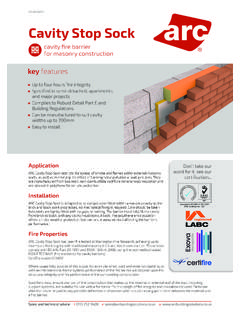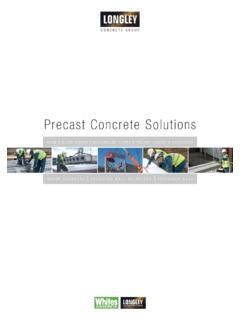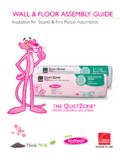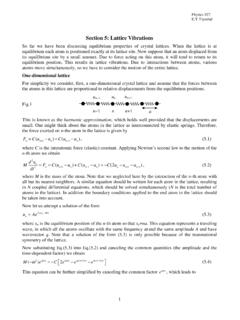Transcription of Materials and Manufacturing - NASA
1 To build a spacecraft, we must begin with Materials . Sometimes the Materials and material choice is the solution. Other times, the design must Manufacturing accommodate the limitations of Materials properties. The design of the Space Shuttle systems encountered many material challenges, such as Introduction weight savings, reusability, and operating in the space environment. Gail Chapline NASA also faced Manufacturing challenges, such as evolving federal Nondestructive Testing Innovations regulations, the limited production of the systems, and maintaining Willard Castner flight certification. These constraints drove many innovative Materials Patricia Howell solutions. Innovations such as large composite payload bay doors, James Walker Friction Stir Welding Advancements nondestructive Materials evaluation, the super lightweight tank, and Robert Ding the understanding of hydrogen effects on Materials were pathfinders Jim Butler used in today's industry.
2 In addition, there were Materials innovations Characterization of Materials in engineering testing, flight analysis, and Manufacturing processes. in the Hydrogen Environment Jon Frandsen In many areas, Materials innovations overcame launch, landing, and Jonathan Burkholder low-Earth orbit operational challenges as well as environmental Gregory Swanson challenges, both in space and on Earth. Space Environment: It's More Than a Vacuum Lubert Leger Steven Koontz Chemical Fingerprinting Michael Killpack Environmental Assurance Anne Meinhold Unprecedented Accomplishments in the Use of Aluminum-Lithium Alloy Preston McGill Jim Butler Myron Pessin Orbiter Payload Bay Door Lubert Leger Ivan Spiker 200 Engineering Innovations Nondestructive inspection. In the industrial world, (detected by the human eye vs. an visual examination can be quite formal, electronic x-ray detector).
3 Testing Innovations with complex visual aids, pass/fail Nondestructive testing is a routine criteria, training requirements, and part of a spacecraft's life cycle. For the Have you ever selected a piece of fruit written procedures. reusable shuttle, nondestructive testing based on its appearance or squeezed Nondestructive testing depends on began during the Manufacturing and it for that certain feel? Of course you incident or input energy that interacts test phases and was applied throughout have. We all have. In a sense, you with the material or part being examined. its service life. NASA performed performed a nondestructive test. The incident or input energy can be many such nondestructive tests on the Actually, we perform nondestructive modified by reflection from interaction shuttle vehicles and developed most testing every day.
4 We visually examine within or transmission through the nondestructive testing innovations in or evaluate the things we use and buy material or part. The process of response to shuttle problems. to see whether they are suitable for their detection and interpretation of the purpose. In most cases, we give the modified energy is how nondestructive item just a cursory glance or squeeze; testing provides knowledge about the Quantitative Nondestructive however, in some cases, we give it material or part. Tests range from the Testing of Fatigue Cracks a conscious and detailed examination. simple detection and interpretation of One of the most significant We don't think of these routine reflected visible light by the human eye nondestructive testing innovations examinations as nondestructive tests, (visual examination) to the complex was quantifying the flaw sizes that but they are, and they give us a sense of electronic detection and mathematical conventional nondestructive testing what nondestructive testing is about.
5 Reconstruction of through-transmitted methods could reliably detect. NASA. Nondestructive testing is defined as the x-radiation (computerized axial used artificially induced fatigue cracks inspection or examination of Materials , tomography [CAT] scan). From a to make the determination because parts, and structures to determine their nondestructive testing perspective, the such flaws were relatively easy to integrity and future usefulness without similarity between the simple visual grow and control, hard to detect, and compromising or affecting their examination and the complex CAT scan tended to bound the population of usefulness. The most fundamental is the input energy (visible light vs. flaws of interest. The need to quantify nondestructive test of all is visual x-rays) and the modified energy the reliably detectable crack sizes was Two examples of the most basic nondestructive testing: Left, a gardener checks ripening vegetables.
6 Right, Astronaut Eileen Collins, STS-114 (2005) mission commander, looks closely at a reinforced carbon-carbon panel on one of the wings of the Space Shuttle Atlantis in the Orbiter Processing Facility at Kennedy Space Center (KSC). Collins and the other crew members were at KSC to take part in hands-on equipment and Orbiter familiarization. Engineering Innovations 201. mandated by a fracture control interest in having confidence in the starting crack size that could be used in Quantitative Nondestructive Testing fracture and life calculations. Although there was no innovation of any specific nondestructive testing method, quantifying in a statistical way the reliably detectable crack sizes associated with the conventional nondestructive evaluation methods was innovative and led the way to the adoption of similar Penetrant Penetrant quantitative nondestructive evaluation Inspection Inspection practices in other industries.
7 Fatigue-cracked Panel Ultrasonic Ultrasonic Inspection The quantification of nondestructive Inspection testing methods is commonly referred P X-ray X-ray Inspection Probability of Detection Curve to today as probability of detection. 100. Inspection The Space Shuttle Program developed 90 Eddy Current some of the earliest data for the 80. Inspection Eddy Current Inspection penetrant, x-ray, ultrasonic, and eddy Probability of Detection (%). 70. current nondestructive testing 60. methods the principal nondestructive 50. testing methods used to inspect shuttle 40. components during Manufacturing . 30. Data showed that inspectors certified to 20. aerospace inspection standards could, 10. on average, perform to a certain 0. probability of detection level defined Flaw Size Increasing as standard nondestructive evaluation. Beyond standard nondestructive The special probability of detection nature, NASA examined a number of evaluation, NASA introduced a special specimen sets typically consisted of nondestructive testing methods.
8 Nondestructive evaluation level of 29 randomly distributed cracks of probability of detection wherein the approximately the same size. By Acoustic Emission Monitoring detection of cracks smaller than the detecting all 29 cracks, the inspector standard sizes had to be demonstrated Late in the development of the shuttle and the specific nondestructive by test. Engineers fabricated fatigue- Thermal Protection System and evaluation process were considered cracked specimens that were used over just before the first shuttle launch, capable of detecting the crack size to many years to certify and recertify, by NASA encountered a major problem a 90% probability of detection with test, the inspectors and their with the attachment of the tiles to the 95% confidence. nondestructive evaluation processes to Orbiter's exterior skin. The bond the smaller, special nondestructive strength of the tile system was lower evaluation crack size.
9 The size of the Nondestructive Testing of than the already-low strength of the fatigue cracks in the specimens was Thermal Protection System Tiles tile material , and this was not targeted to be a surface-breaking accounted for in the design. The low semicircular crack cm ( in.) The development of Thermal Protection bond strength was due to stress long by cm ( in.) deep, a System tiles was one of the most concentrations at the tile-to-strain size that was significantly smaller than unique and difficult developments of isolation pad bond line interface. the standard nondestructive evaluation the program. Because of this material 's A Nomex felt strain isolation pad crack size of cm ( in.) long unknowns, the tile attachment was bonded between each tile and by cm ( in.) deep. scheme, and their extremely fragile the Orbiter skin to minimize the 202 Engineering Innovations lateral strain input to the tile from the aluminum skin.
10 These stress concentrations led to early and Acoustic Emission Monitoring of Tiles During Proof Test progressive failures of the tile material at the tile-to-strain isolation Coating pad bond line interface when the tile was loaded. T Tile Attachment Scheme To determine whether low bond strengths existed, engineers resorted to Tile Body proof testing for each tile. This required Silicon Rubber (RTV 560). thousands of individual tile proof tests Nomex Strain prior to first flight. Space Shuttle Isolation Pad Silicon Rubber Columbia (Space Transportation (RTV 560). System [STS]-1) was at Kennedy Space Primer Center being readied for first flight Aluminum when NASA decided that proof testing Substrate was necessary. Since proof testing was not necessarily nondestructive and tiles could be damaged by the test, NASA sought a means of monitoring potential damage; acoustic emission Tile Proof Test Acoustic Emission nondestructive testing was an obvious Sensor Proof To Acoustic Emission choice.
















